Room Inspection Checklist Samples
-
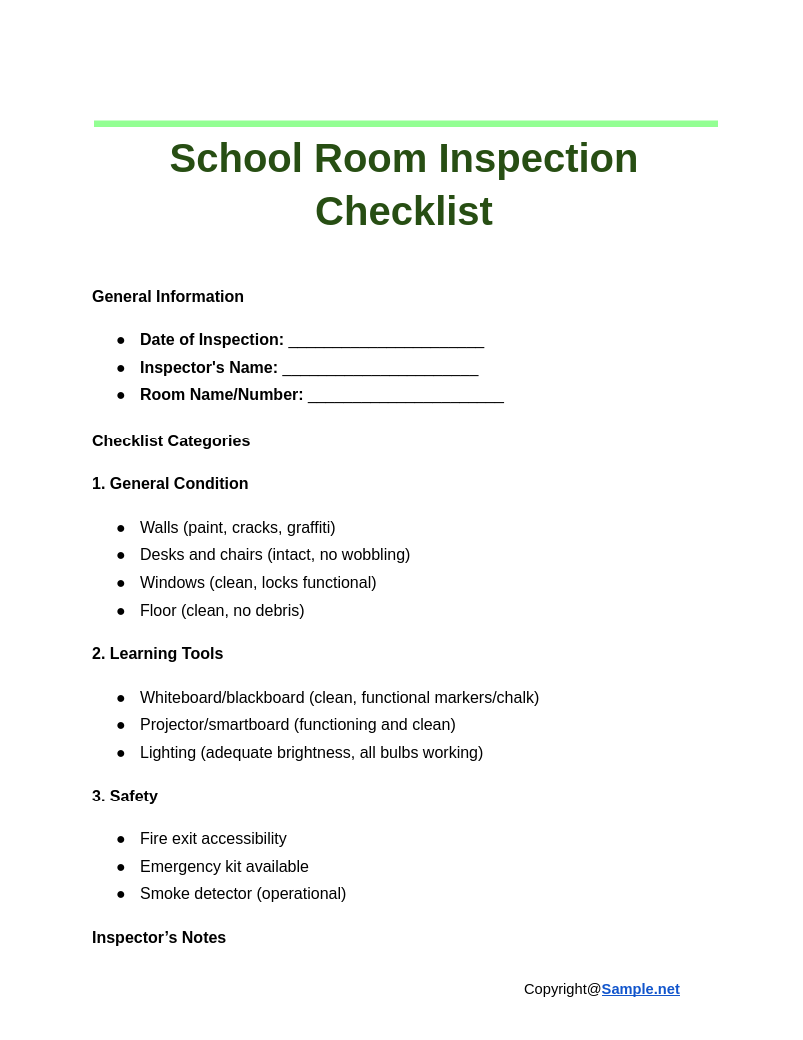
School Room Inspection Checklist
download now -
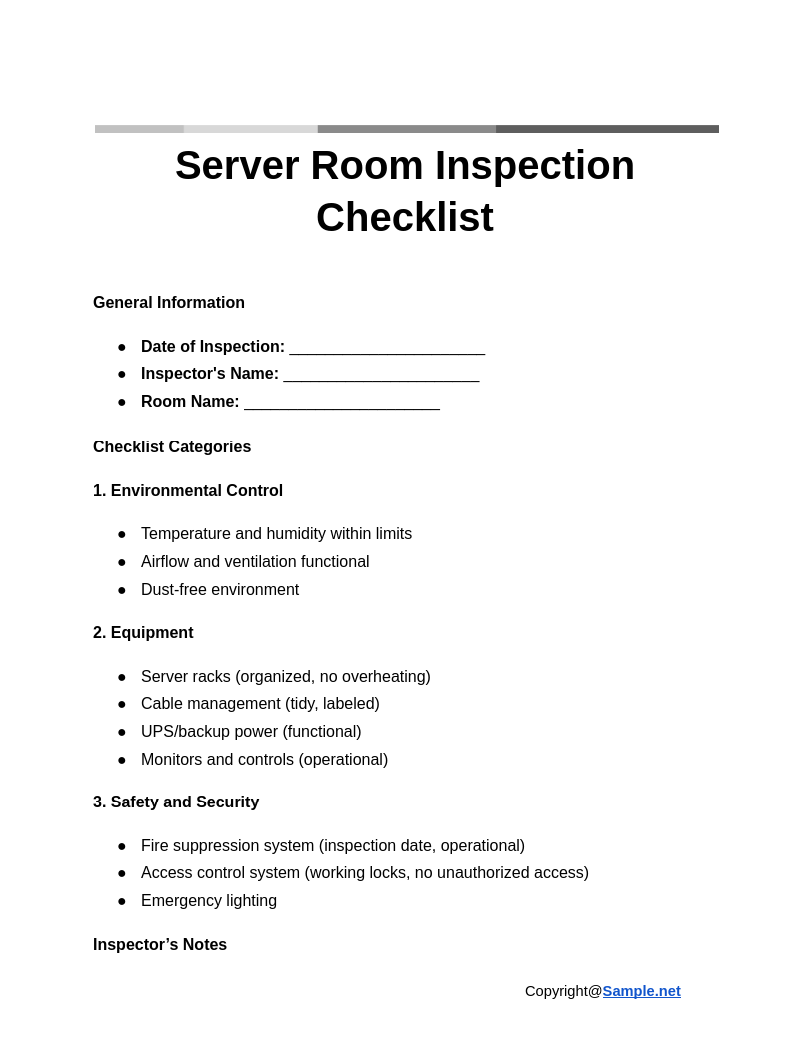
Server Room Inspection Checklist
download now -
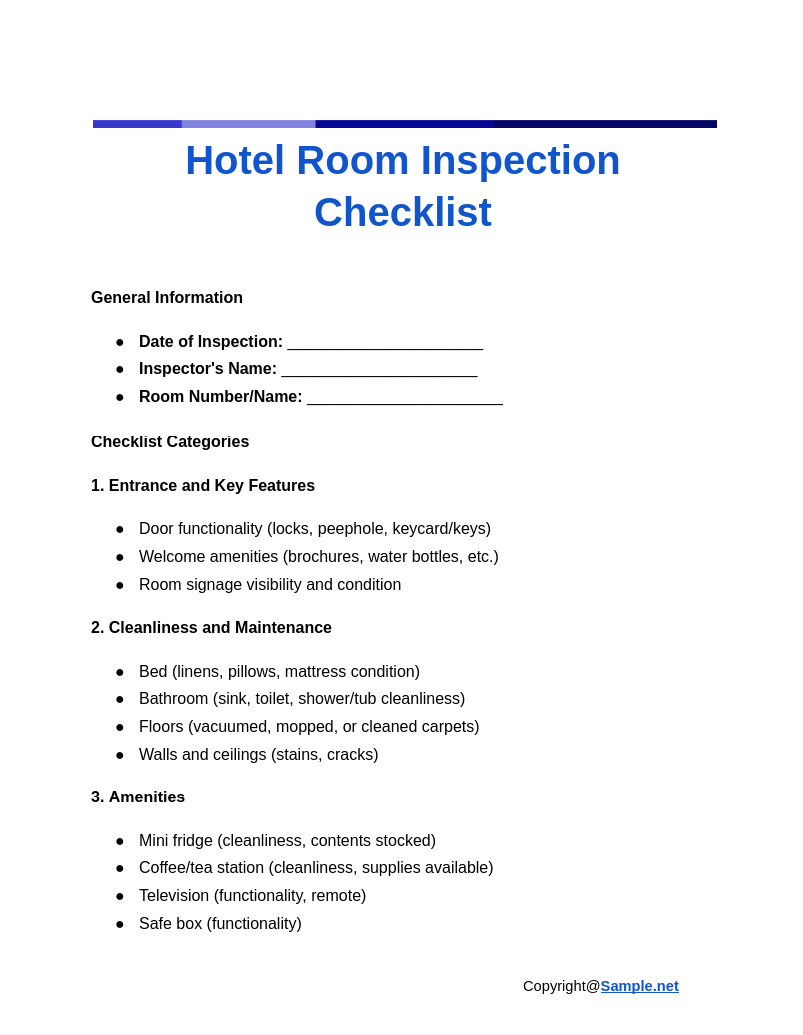
Hotel Room Inspection Checklist
download now -

Guest Room Inspection Checklist
download now -
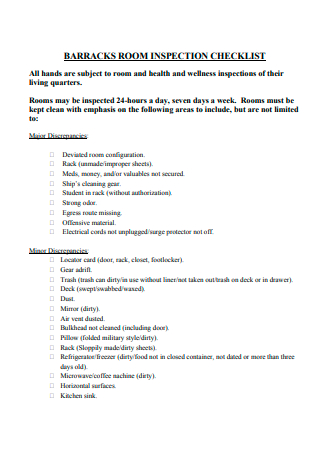
Room Inspection Checklist Template
download now -

Evidence Room Inspection Checklist
download now -
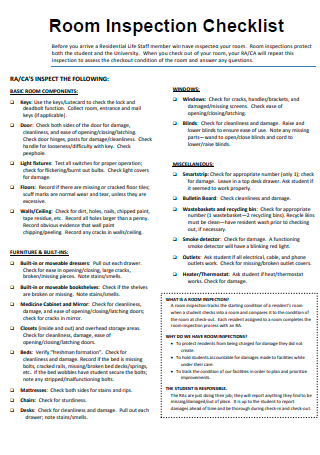
Printable Room Inspection Checklist
download now -
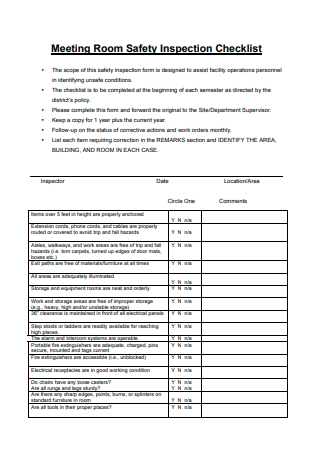
Meeting Room Safety Inspection Checklist
download now -
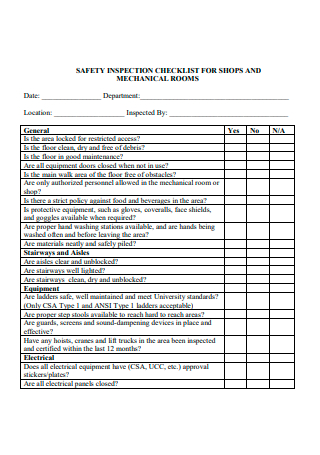
Mechanical Room Safety Inspection Checklist
download now -
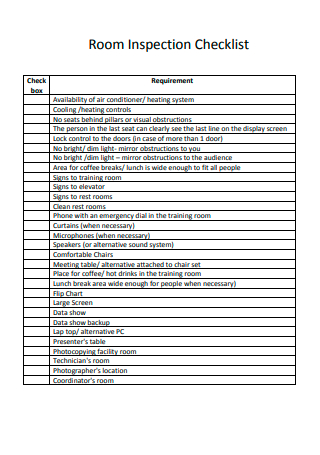
Room Inspection Checklist Example
download now -
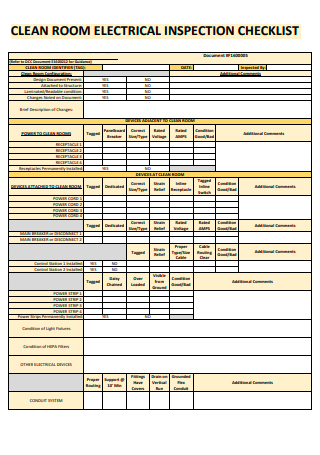
Clean Room Electrical Inspection Checklist
download now -
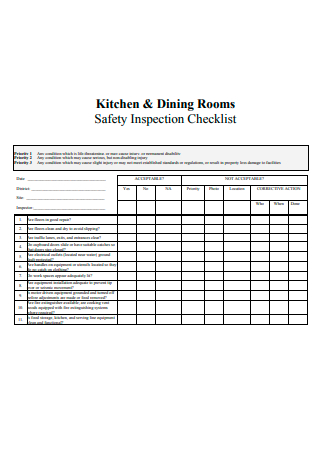
Kitchen and Dining Room Safety Inspection Checklist
download now -
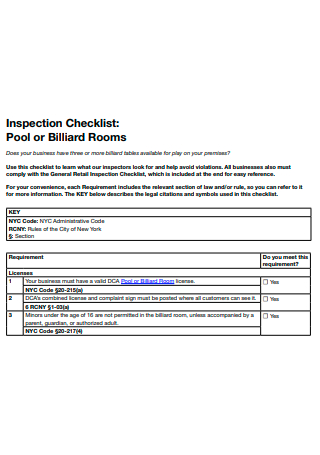
Billiard Room Inspection Checklist
download now -
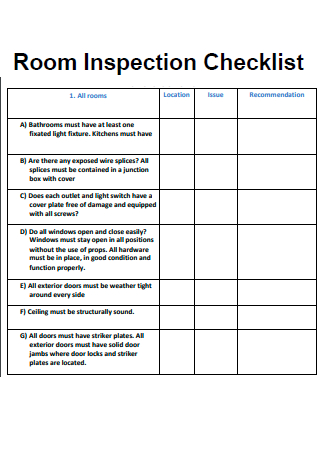
Room Inspection Checklist in PDF
download now -
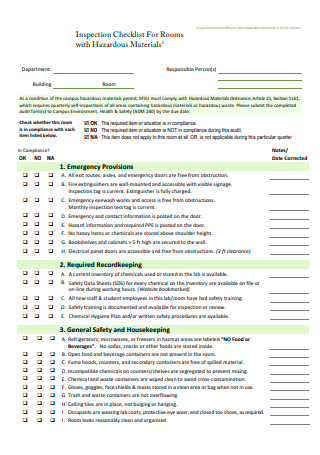
Room with Materials Inspection Checklist
download now -
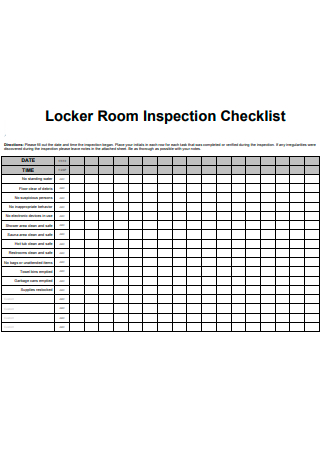
Locker Room Inspection Checklist
download now -
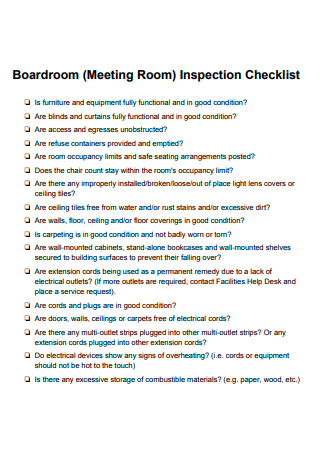
Board Meeting Room Inspection Checklist
download now -
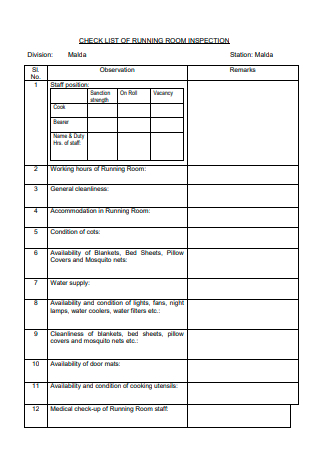
Running Room Inspection Checklist
download now -
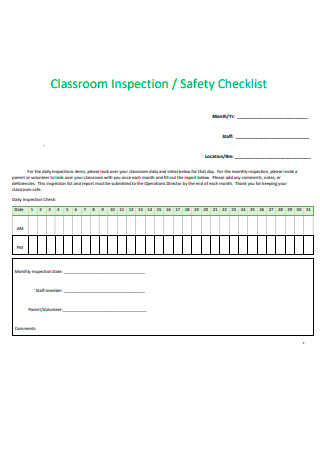
Class Room Inspection Safety Checklist
download now -

Basic Room Inspection Checklist
download now -
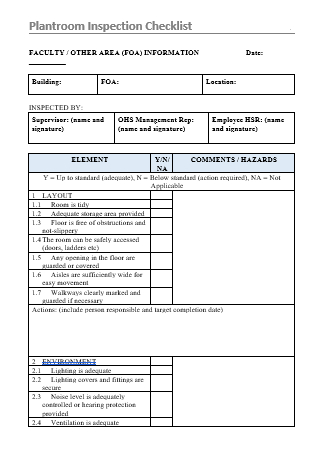
Plant Room Inspection Checklist
download now
FREE Room Inspection Checklist s to Download
Room Inspection Checklist Format
Room Inspection Checklist Samples
What is a Room Inspection Checklist?
Purposes of a Room Inspection Checklist
How to Make a Room Inspection Checklist
FAQs
What role does final inspection play?
What is the purpose of a room inspection?
What does a room inspection entail?
How do you align a work plan with organizational goals?
Can a work plan be used for personal goals?
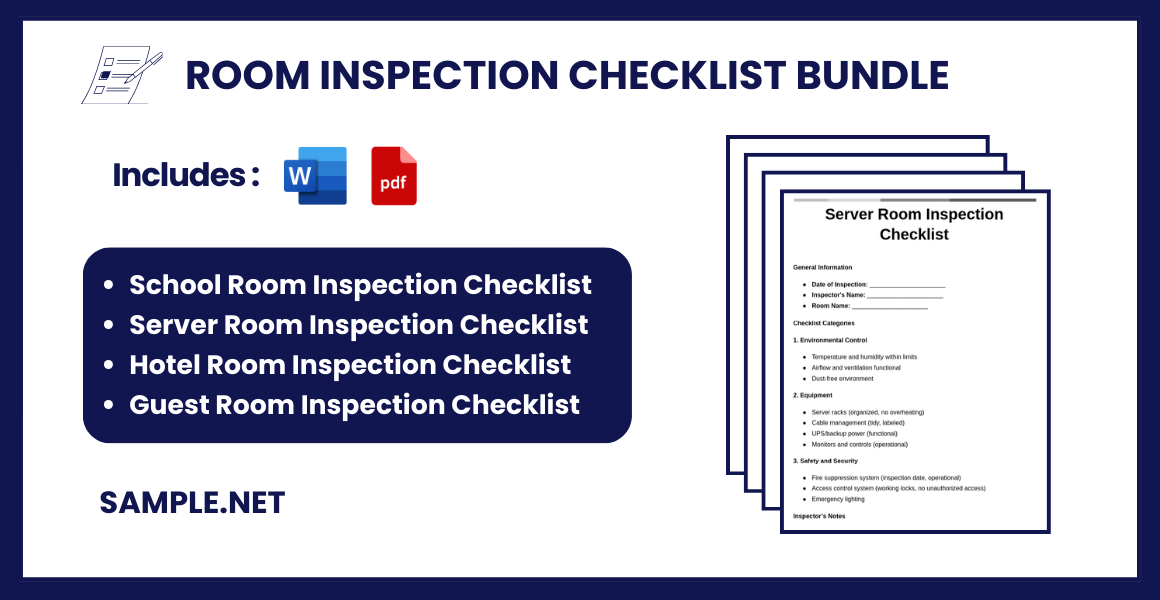
Download Room Inspection Checklist Bundle
Room Inspection Checklist Format
General Information
- Date of Inspection: ______________________
- Inspector’s Name: ______________________
- Room Number/Name: ______________________
- Type of Room: ______________________
- Purpose of Inspection: ______________________
Checklist Categories
1. Entrance and Exterior
- Door functionality (locks, hinges, peephole, and handle)
- Door cleanliness and condition (scratches, dents)
- Lighting outside the room
- Room signage visibility and condition
- Doormat condition
2. Interior Condition
- Walls (paint, marks, cracks)
- Ceiling (stains, cracks)
- Flooring (cleanliness, scratches, or stains)
- Windows (cleanliness, locks, curtains/blinds functionality)
- Lighting (brightness, functioning bulbs)
3. Furniture and Fixtures
- Bed and mattress (cleanliness, stability, linens)
- Tables and chairs (condition, scratches, wobbling)
- Wardrobe and shelves (cleanliness, hinges, drawers)
- Electrical outlets (functionality and safety)
4. Bathroom
- Sink and faucet (cleanliness, water flow, drainage)
- Toilet (cleanliness, flushing functionality)
- Shower and bathtub (cleanliness, water pressure, drainage)
- Mirrors (cleanliness, cracks)
- Towels and toiletries (availability and cleanliness)
5. Safety and Security
- Smoke detectors and fire alarms (functionality)
- Emergency exit map (visibility and accuracy)
- Fire extinguisher (location and condition)
- First aid kit (availability and contents)
6. Additional Amenities
- Mini fridge (cleanliness, functionality)
- Television (remote, channels, functionality)
- Air conditioning/heating (functionality, controls)
- Telephone (functionality, directory availability)
Inspector’s Notes
Overall Room Condition
- Excellent
- Good
- Needs Improvement
Signature
- Inspector’s Signature: ___________________________
- Date: ___________________________
What is a Room Inspection Checklist?
A Room Inspection Checklist is a predefined list of tasks or items used to assess the condition of a room. It includes key elements such as cleanliness, functionality of appliances, structural integrity, and safety measures. This checklist ensures every aspect of the room is evaluated, helping property managers, homeowners, and hotel staff maintain quality standards. By following this checklist, any issues can be addressed promptly, minimizing potential risks and preserving the space’s overall appeal. You can also see more on Housekeeping Checklist.
Purposes of a Room Inspection Checklist
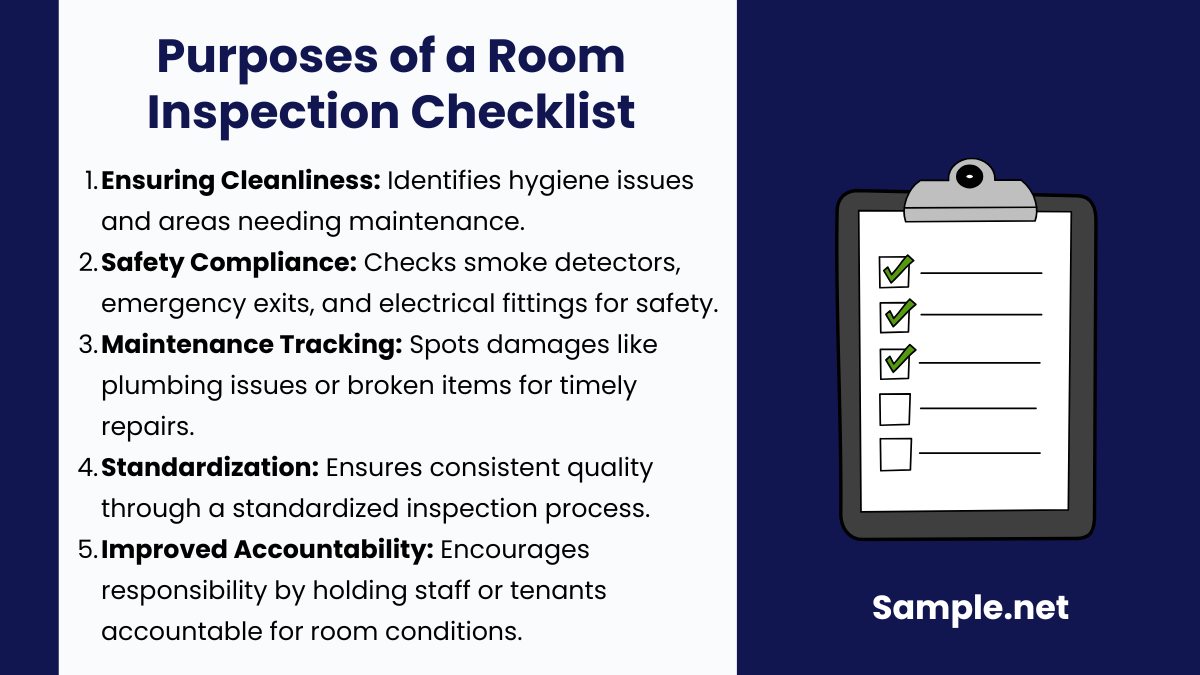
1. Ensuring Cleanliness
A room inspection checklist ensures that all areas meet hygiene and cleanliness standards. It helps identify unclean spots or areas requiring maintenance.
2. Safety Compliance
The checklist verifies that all safety measures, such as smoke detectors, emergency exits, and electrical fittings, are functioning properly to minimize risks. You can also see more on Guest Room Checklist.
3. Maintenance Tracking
It helps identify wear and tear or damages in the room, such as plumbing issues, broken furniture, or malfunctioning appliances, ensuring timely repairs.
4. Standardization
A room inspection checklist ensures consistency in quality by standardizing the inspection process, regardless of who performs it.
5. Improved Accountability
By using the checklist, staff or tenants are held accountable for maintaining the room’s condition, fostering a sense of responsibility. You can also see more on Inspection Checklists.
How to Make a Room Inspection Checklist

Working in a hotel or any other establishment may require you to do numerous handful tasks, although the chances of it varying for each company is possible, more or less the room inspection procedure is similar. The tasks have been broken down into sub-categories to make them easier to follow. These include duties such as beds, walls, and ceilings, as well as necessary amenities in the room. Keep your chosen template from above nearby as the steps below will merely guide you and you will have to analyze if they match your company’s preferences. At the end of the examination, you may need to write up an Inspection Report.
Step 1: Check the Overall Room
Upon arrival, the room needs to be at a pleasant temperature. Guests may be bothered if the room temperature is not desirable or comfortable to stay in. Check your air conditioners that they are in working condition and are free of dirt and dust. Also, double-check that the air conditioner’s controls are operational, this goes for a functional knob or remote control. Because most visitors will be using their mobile devices, Wifi should be available throughout the space. Otherwise, if it is sluggish or non-existent, people may complain.
Step 2: Review Other Furniture
Examine the furnishings carefully. They should be spotless, devoid of stains and scratches, and clear of any residues of water or cleaning substances. Examine the bed structure for stability and cleanliness. The headboard must also be in excellent working order. Check to see if the bedding is clean and stain-free. The mattress should be firm and the pillows should be fluffed. Make sure there are no tears around the edges of the blanket. A garbage container that is clean and empty should be provided. You can also see more on Rental Inspection Checklists.
Check to see if the television remote is in functioning order. The television should be turned off, and remote controls should be placed where they can be seen. The phone should be operational. A minimum of three hangers should be accessible in the closet. Make sure you have all of the necessary desk supplies. A bible, a hotel pen, and a memo pad should all be included. The drawers on the nightstand should be tidy and functioning (draw and retract quickly and silently). This is optional, however, you should inspect the contents and functionality of the mini-refrigerator.
Step 3: Test the Light and Electricity
Make certain that all of the light switches are operational. Make sure that the lamps are in working order. Dust should be removed from both the desk light and the standing lamp. This also goes for the electricity within the room. Guests would want to utilize the devices and other amenities in the room, so make sure that plugs and switches are working properly. Sockets should be tightly shut to avoid accidents from occurring but easily spotted and usable for guests who may need to charge their devices. Make sure nothing is obstructing them and also accessible enough to not give a hassle to the guests. You can also see more on Facility Inspection Checklist.
Step 4: Survey the Walls, Floors, and Windows
Make sure the windows and curtains are clean and free of dust. The windows should be spotless and devoid of any squeaks. The drapes should be clear of dust. Make sure the windows and curtains are both easy to open and close. The second item you should look at is the room’s carpet and flooring. Check that the carpet is not frayed and that the floors are clean and free of damp patches to guarantee that the carpet and flooring are in excellent shape. Cobwebs, scrapes, and nicks should be removed from the walls. Ensure that all of the artwork and photographs on the walls are hanging straight. The mirror on the wall should be hung correctly and wiped clean.
A Room Inspection Checklist simplifies room evaluations by ensuring all critical aspects are checked. It enhances property maintenance, prevents disputes, and improves customer satisfaction. Whether managing a rental or a hotel, using this checklist helps uphold quality standards and ensures every room meets expectations consistently and efficiently. You can also see more on Home Inspection Checklist.
FAQs
What role does final inspection play?
The final inspection is crucial since it confirms that there have been no major modifications or damage to the room, as well as that the items your visitors are purchasing are in great shape. Your company is preparing the rooms for your guests by conducting the last inspection, ensuring that they have the greatest possible experience and comfort during their stay with you.
What is the purpose of a room inspection?
A room inspection is required to ensure the space’s overall quality. The preparation must meet the demands of the guests and be flawless in every way: hygiene, tidiness, and comfort. Alternatively, a Cleaning List can be used in place of a checklist as it functions the same way in making sure nothing is left uncleaned.
What does a room inspection entail?
The main goal of a room inspection is to detect any faults that may have been ignored during cleaning and become a source of discontent and complaints before they are discovered by the visitor.
How do you align a work plan with organizational goals?
Ensure that the work plan’s objectives contribute to the broader mission of the organization. Involve stakeholders to align priorities and integrate feedback into the planning process. You can also see more on Move-in / Move-out Inspection Checklists.
Can a work plan be used for personal goals?
Yes, personal work plans help individuals set goals, manage time, and track progress in areas like fitness, education, or career development, promoting productivity and accountability. You can also see more on Safety Inspection Checklists.
